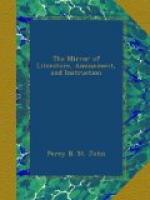It should be noticed, however, that about a month before Franklin had made these successful trials, some philosophers, in particular Dalibard and De Lors, had obtained similar results in France, by following the plan recommended by Franklin. But the glory of the discovery is universally given to Franklin, as it was from his suggestions that the methods of attaining it were originally derived.
This important discovery was prosecuted with great ardour by philosophers in every part of Europe. The first experimenters incurred considerable risk in their attempts to draw down electricity from the clouds, as was soon proved by the fatal catastrophe, which, on the 6th of August, 1753, befel Professor Richman, of Petersburg. He had constructed an apparatus for observations on atmospherical electricity, and was attending a meeting of the Academy of Sciences, when the sound of distant thunder caught his ear. He immediately hastened home, taking with him his engraver, Sokolow, in order that he might delineate the appearances that should present themselves. While intent upon examining the electrometer, a large globe of fire flashed from the conducting rod, which was insulated, to the head of Richman, and passing through his body, instantly deprived him of life. A red spot was found on his forehead, where the electricity had entered, his shoe was burst open, and part of his clothes singed. His companion was struck down, and remained senseless for some time; the door-case of the room was split, and the door itself torn off its hinges.




